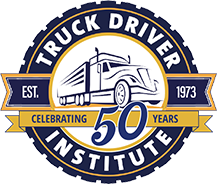Truck Driver Safety Tips & Good Practices
Driving a truck professionally is a difficult job. Not only does it require a great deal of skill, but there’s a lot of personal responsibility for the safety of others while sharing the road. Truck Driver Institute has created this list truck driver safety tips for drivers in order to keep them safe:
- Wear your seatbelt
- Don’t use your cell phone while driving
- Use safety signals
- Know your route
- Use a truck drivers’ GPS
- Be aware of speed limits
- Be cautious when driving at night
- Get enough sleep
- Practice work zone safety
- Maintain your vehicle
While some of these truck driver safety tips may seem obvious at first, it’s important to follow all of the available safety guidelines to protect yourself and others on the road. Read on to learn more about each tip and stay informed.
Truck Driver Safety Tips
1. Wear your seatbelt.
Of all the truck driver safety tips and good practices, this may be the most important. The use of these safety belts is not only required by law, they’re the easiest way to prevent injuries. Studies show that roughly 15% of truck drivers do not wear their seat belts. Wearing a seat belt could save your life in the event of a wreck. The lack of safety belts is responsible for over 40% of annual crash-related deaths.
2. Don’t use your cell phone while driving and don’t drive distracted.
Cell phones should never be used by drivers, no matter if they’re behind the wheel of a sedan or 18-wheel truck. 48 states have passed laws to make texting while driving illegal and between 2012 through 2018, over 23000 people have died in crashes involving distracted drivers. Truck drivers should keep their eyes on the road, not on their phones. Doing so could save lives.
3. Use safety signals and keep lane changes to a minimum.
Using turn signals lets other drivers know your intentions on the road. An 18-wheeler takes up a lot of space on a highway and giving lots of notice keeps you and other drivers safe. Maintain a safe distance from other cars, and stick to one lane as much as possible. Other drivers may weave in and out of lanes, so your choice to drive defensively will keep your rig out of wrecks.
4. Know your route.
One of the best of the truck driver safety tips is one of the simplest: know your route. Having a plan in place before you get into your vehicle can save you a headache on the road. Know how many hours you plan to drive each day, as well as main and alternate routes in case of construction or accidents. Be aware of expected weather conditions along the way. The more prepared you can be before you begin your drive, the safer your journey will be.
5. Use a truck drivers’ GPS but don’t rely too heavily on them.
A truck drivers’ GPS will show vital information like traffic reports, which exits to take, and when to change lanes. This information can be incredibly helpful, even to drivers who have planned out their routes. They can alleviate a lot of stress for drivers who are traveling in unfamiliar areas. This GPS is an incredible tool but is not foolproof. Drivers should never totally rely on them, they should always do research on their route ahead of time and supplement with the GPS.
6. Be aware of speed limits and slow down.
Driving a big truck is very different from driving a sports car; they don’t corner or handle well at all. Do not treat the highway as your personal racetrack, and never attempt to hit a top speed. Speed limits on ramps are for cars, not commercial trucks. Take your time and stay upright, even if you feel like you’re holding up traffic! Having a trailer tip over or getting in an accident because you couldn’t slow down in time are totally avoidable if you’re driving cautiously.
7. Be cautious when driving at night.
Many trucking routes cross through rural areas of the country. These roads are unlit, which makes driving in the dark hazardous. It can be difficult to see any potholes or bumps in the road, and it can be especially dangerous if an animal runs out in front of the truck. When driving in the dark, pay attention to your surroundings and drive defensively.
Make sure that you stay alert while driving at night. Not only are you keeping your eyes on the road, you should be staying aware of other drivers who may be driving dangerously in the dark.
8. Get enough sleep.
A tired driver is a dangerous driver. Make sure that you get plenty of sleep before a long drive, and if you feel eyelids getting heavy while you’re driving, pull over and take a nap. There’s no sense in pushing forward if you’re ready to fall asleep behind the wheel of a semi truck.
Drowsiness makes you less able to pay attention to the road and affects your ability to make good decisions and react quickly. The National Highway Traffic Safety Administration estimates that over 72,000 crashes in 2013 can be attributed to driving while drowsy.
9. Practice work zone safety.
The summer months bring heavy road construction, which is not ideal when driving on major highways. Work zones present a number of hazards like lane shifts, sudden stops, uneven road conditions, and construction workers on site. Add confused passenger vehicle drivers to that mix and getting through a work site can be a very dangerous task.
Drive slowly, and be prepared to stop at any time while passing through a work zone. Leave extra space between your truck and the vehicle ahead of you, and be alert for other cars entering your blind spots as the lane patterns change. Be alert for road crews and obey all posted signage.
10. Maintain your vehicle.
Make sure that you are constantly inspecting your truck and trailer at every stop. Ensure that your tires are at the proper pressure and that your brakes are not worn down. Make sure that what you’re hauling is secured properly and well-balanced. Failure to do so may cause a rollover or loss of control and loose materials can be hazardous to other drivers.
A Safe Truck Driver Is A Good Truck Driver
If driving safely and seeing the country appeal to you, you can learn to be a trucker at Truck Driver Institute. You can earn your Commercial Driver’s License in as little as three weeks. We also provide competitive tuition rates and consistent job placement.
Ready to hit the road and see the country like only a truck driver can? Find the right Truck Driver Institute training location or contact us today!
Get Started
Get your Class A CDL in our friendly, supportive CDL training program. TRAIN with experienced instructors – multiple good-paying, secure job choices with benefits available for eligible graduates. EARN $700 – $1000+ / week to start as a truck driver. Get started today by filling out the form below. We look forward to hearing from you!

